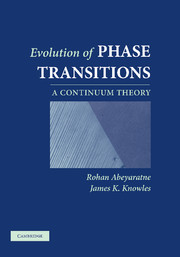Book contents
- Frontmatter
- Contents
- Preface
- Part I Introduction
- Part II Purely Mechanical Theory
- 2 Two-Well Potentials, Governing Equations and Energetics
- 3 Equilibrium Phase Mixtures and Quasistatic Processes
- 4 Impact-Induced Transitions in Two-Phase Elastic Materials
- Part III Thermomechanical Theory
- Part IV One-Dimensional Thermoelastic Theory and Problems
- Part V Higher Dimensional Problems
- Author Index
- Subject Index
4 - Impact-Induced Transitions in Two-Phase Elastic Materials
Published online by Cambridge University Press: 12 August 2009
- Frontmatter
- Contents
- Preface
- Part I Introduction
- Part II Purely Mechanical Theory
- 2 Two-Well Potentials, Governing Equations and Energetics
- 3 Equilibrium Phase Mixtures and Quasistatic Processes
- 4 Impact-Induced Transitions in Two-Phase Elastic Materials
- Part III Thermomechanical Theory
- Part IV One-Dimensional Thermoelastic Theory and Problems
- Part V Higher Dimensional Problems
- Author Index
- Subject Index
Summary
Introduction
We next turn to the dynamics of the two-phase nonlinearly elastic materials introduced in Chapter 2. As in the theory of mixed-phase equilibria and quasistatic processes for such materials set out in Chapter 3, the notion of driving force plays a central role in the analysis when inertial effects are taken into account. The indeterminacy exhibited in Chapter 3 by even the simplest static or quasistatic problems for two-phase materials manifests itself again in the present much richer dynamical context. Moreover, the continuum-mechanical interpretations of nucleation and kinetics again serve to restore the uniqueness of solutions to the dynamic problems to be considered here. As in the preceding chapters, thermal effects are omitted; they will be included in the more general settings of later chapters.
The main vehicle for our study of one-dimensional dynamics of two-phase materials is the impact problem. There is an enormous body of experimental literature pertaining to the response of solids to shock or impact loading, much of it motivated by questions concerning the behavior of materials at extremely high pressures, as occurs, for example, deep in the earth. The reader will find some guidance to the experimental literature in this field of the dynamic behavior of materials in the books by Graham [11] and Meyers [25].
- Type
- Chapter
- Information
- Evolution of Phase TransitionsA Continuum Theory, pp. 59 - 82Publisher: Cambridge University PressPrint publication year: 2006



